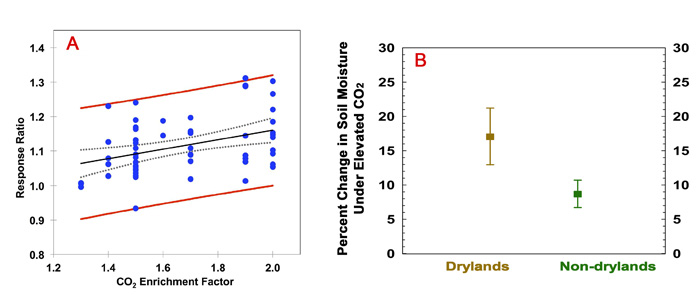| Follow @co2science |
Paper Reviewed
Lu, X., Wang, L. and McCabe, M.F. 2016. Elevated CO2 as a driver of global dryland greening. Scientific Reports 6: 20716, doi:10.1038/srep20716.
Despite continued attempts by alarmists to portray rising atmospheric carbon dioxide (CO2) as a danger and threat to the planet, more and more scientific evidence is revealing nothing could be further from the truth. The latest example to demonstrate such comes from a paper recently published in the journal Scientific Reports, where Lu et al. (2016) investigated the role of atmospheric CO2 in causing the satellite-observed vegetative greening of the planet that has occurred over the past few decades (1960-2015).
It has long been known that rising CO2 boosts plant productivity and growth, and it is equally well-established that increased levels of atmospheric CO2 reduce plant water needs/requirements, thereby improving their water use efficiency. In consequence of these two benefits, Lu et al. hypothesized that rising atmospheric CO2 is playing a significant role in the observed greening, especially in moisture-limited areas where soil water content is a limiting factor in vegetative growth and function. And to test their hypothesis, the three scientists conducted a meta-analysis that included 1705 field measurements from 21 distinct sites from which they evaluated the effects of atmospheric CO2 enrichment on soil water content in both dryland and non-dryland systems.
According to the authors, the meta-analysis revealed that "increasing atmospheric CO2 to between 1.2 to 2.0 times the ambient CO2 level has a positive effect on soil water content" (Panel A, figure below). What is more, the CO2-induced increase in soil water content was found to be greater in drylands (17%) than non-drylands (9%) (Panel B, figure below). Lu et al. also note their analysis showed "no evidence for any significant effects" of soil texture, vegetation type, land management practices or climate regime on soil water content under elevated CO2 conditions. Given as much, they conclude that considering the inherent water limitation in drylands, the additional soil water availability brought about by rising atmospheric CO2 concentrations over the past half-century is "a likely driver of observed increases in vegetation greenness" during this period.
And thus it is that we have yet another study indicating rising atmospheric CO2 is benefiting the biosphere, as opposed to harming it.

Figure 1. (Panel A) Sensitivity of the soil water response ratio to CO2 enrichment for the entire data set, calculated as the soil water content under elevated CO2 divided by the soil water content under ambient CO2. The closed circles are the observations, with the solid black line providing a linear regression. The red lines represent the 95% confidence intervals of the observations and the dashed grey lines represent the 95% confidence interval of the model. (Panel B) Enhancement of soil water content under elevated CO2 for dryland versus non-dryland regimes. Adapted from Lu et al. (2016).




